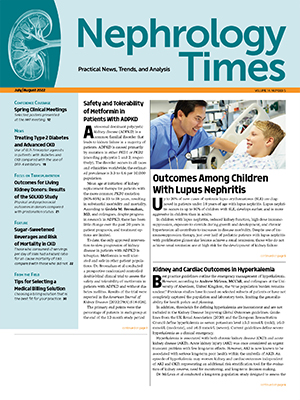
There have been advancements in knowledge regarding mitigation of poor outcomes in hepatorenal syndrome. However, according to Jose Luis Zabala Genovez, MD, and colleagues, “Specific therapeutic gaps have not been addressed effectively over the past 20 years in the United States. Mortality rates and predictors that could serve as therapeutic and preventive targets are not well established.”
The researchers conducted a retrospective cohort study of patients with hepatorenal syndrome. Results were reported during a poster session at NKF SCM22 in a poster titled Hepatorenal Syndrome in the United States: A Temporal Trend of In-Hospital Mortality and Its Predictors.
The study utilized data from the National Inpatient Sample database and included 4938 (unweighted sample) and 23,973 (weighted sample) hospital admissions for hepatorenal syndrome from 2005 to 2014. The primary outcomes of interest were temporal trends in mortality and predictors for hospital mortality. Estimated odds ratios from multi-level mixed-effect logistic regression were used to identify patient characteristics and treatments associated with in-hospital mortality.
In 2005, the rate of in-hospital mortality was 44%; in-hospital mortality decreased to 24% in 2014. There were increased rates of liver transplantation, kidney replacement therapy, length of stay, and hospitalization cost. Following multivariable adjustment, there were associations between older age, alcohol use, coagulopathy, neurological disorder, and need for mechanical ventilation with higher mortality. There were also associations between liver transplantation, transjugular intrahepatic portosystemic shunt (TIPS), and abdominal paracentesis with lower in-hospital mortality.
“Our study shows an apparent reduction in mortality, and this reduction might explain the increased length of stay and higher resource utilization, including liver transplantation, TIPS, and kidney replacement therapy,” the researchers said. “Interestingly, TIPS and abdominal paracentesis were associated with lower hospital mortality. Predictors of in-hospital mortality are similar to those found in other studies, including older age, coagulopathy, alcohol use, and neurologic disorders.”
Source: Genovez JLZ, Dumancas C, Thongprayoon C, et al. Hepatorenal syndrome in the United States: A temporal trend of in-hospital mortality and its predictors. Abstract of a poster (Poster #25) presented at the National Kidney Foundation 2022 Spring Clinical Meetings, Boston, Massachusetts, April 6-10, 2022.







 © 2025 Mashup Media, LLC, a Formedics Property. All Rights Reserved.
© 2025 Mashup Media, LLC, a Formedics Property. All Rights Reserved.